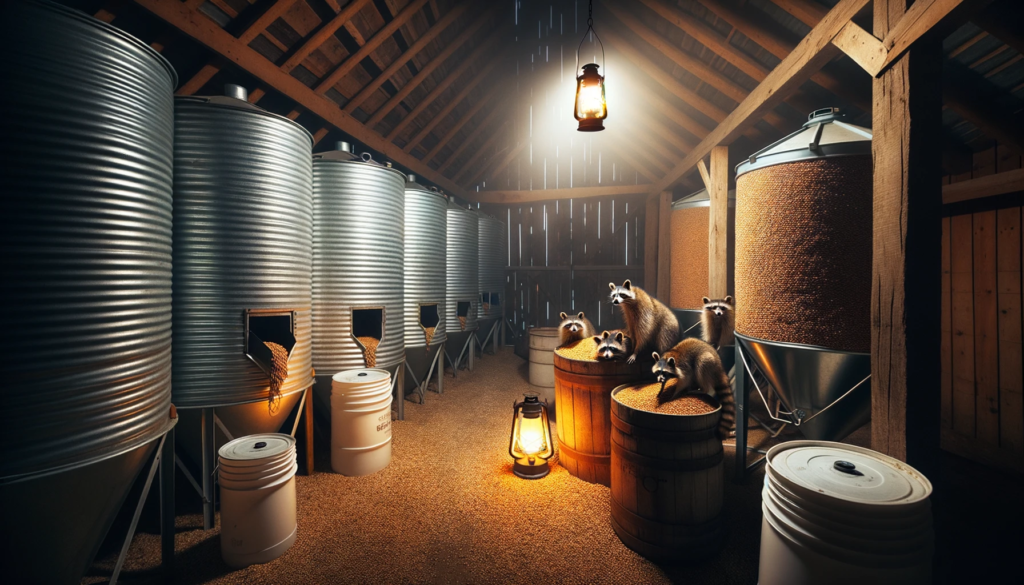 If you’ve ever camped in a barn, you know that raccoons can be a common nuisance. These adorable creatures may look harmless, but they can quickly become a problem if left unchecked. Raccoons can cause damage to your property and pose a threat to your safety if they carry diseases.
In this section, we will share essential tips on how to manage raccoons in barns at your campsite. By preventing them from entering your barn, identifying and addressing raccoon noises, and creating a safe environment, you can enjoy a peaceful and worry-free stay.
So, whether you’re a seasoned camper or a first-timer, read on to learn how to prevent raccoons from intruding on your barn and ensure a fantastic outdoor experience. Let’s get started with raccoon prevention in barns.
If you’ve ever camped in a barn, you know that raccoons can be a common nuisance. These adorable creatures may look harmless, but they can quickly become a problem if left unchecked. Raccoons can cause damage to your property and pose a threat to your safety if they carry diseases.
In this section, we will share essential tips on how to manage raccoons in barns at your campsite. By preventing them from entering your barn, identifying and addressing raccoon noises, and creating a safe environment, you can enjoy a peaceful and worry-free stay.
So, whether you’re a seasoned camper or a first-timer, read on to learn how to prevent raccoons from intruding on your barn and ensure a fantastic outdoor experience. Let’s get started with raccoon prevention in barns.
Understanding Raccoon Behavior in Barns
If you own a barn, it is not uncommon to have uninvited guests, especially raccoons. These creatures are known for their intelligence, dexterity, and adaptability, making them a common sight in both urban and rural areas across North America. Raccoons are opportunistic creatures and are attracted to barns due to the abundance of food, water, and shelter. Barn raccoons are known to establish nests in wall cavities, attics, and other secluded areas. They also feed on stored grains, fruits, vegetables, and livestock feed. However, their presence can cause raccoon infestations in barns, resulting in damage to property and potential health hazards for both humans and animals.Understanding Barn Raccoon Behavior
Raccoons are primarily nocturnal animals, but they can also be active during the day if they feel threatened or need to forage for food. They are excellent climbers and can easily access roofs, walls, and other structures, making it easier for them to establish a nest in your barn. Raccoons are also known to be intelligent and curious creatures, and they will investigate anything that looks interesting or smells appetizing. They have been known to open doors, windows, and even containers to get to food or water. Once they have established a raccoon infestation in barns, they will also create latrines, leaving droppings and urine in corners and other secluded areas of the barn.Raccoon Damage in Barns
Raccoons can cause significant damage to barns. They can chew through wires, insulation, and other building materials, causing electrical and structural damage. They also pose a risk to livestock and other animals, as they can carry and transmit diseases such as rabies and distemper. It is essential to identify and address barn raccoon behavior to prevent damage to property and potential risks to both human and animal health. Proper prevention and control measures can help keep raccoons at bay and ensure a safe and healthy environment in your barn.Preventing Raccoons from Entering Your Barn
If you want to keep raccoons out of your barn, it’s important to take proactive measures to prevent them from entering in the first place. Here are some effective ways to prevent raccoons from entering your barn:| Method | Description |
|---|---|
| Secure entrances | Make sure all entrances to your barn are secure. Raccoons can enter through even small holes or gaps, so ensure all doors, windows, and vents have screens or are tightly sealed. |
| Seal potential entry points | Walk around your barn and look for any potential entry points. Seal any holes or gaps in the walls, roof, or foundation with sturdy materials such as metal flashing or hardware cloth. |
| Implement deterrents | There are several deterrents that can be effective at keeping raccoons away from your barn, including motion-activated lights and sprinklers, loud music or talk radio, and natural repellents such as cayenne pepper or predator urine. |
Recognizing Raccoon Noises in Your Barn
Raccoons are known for their vocalizations, and if you’re hearing strange noises coming from your barn, it could be a sign of a raccoon infestation. Here are some of the common raccoon sounds you might hear:- Chattering: This is a common vocalization that raccoons make when they’re feeling threatened or aggressive. It’s a quick, high-pitched sound that can be alarming to hear.
- Crying: Raccoons make a crying or whining sound when they’re distressed or in pain. If you hear a raccoon crying in your barn, it could be injured or sick.
- Growling: This low-pitched sound indicates aggression and is often heard when two raccoons are fighting or competing for resources.
- Purring: Surprisingly, raccoons also purr when they’re happy and content. This sound is usually heard when a mother raccoon is caring for her young.
How to Remove Raccoons from Your Barn
If you need to remove raccoons from your barn, it’s important to do so safely and humanely. Here are some tips:- Identify Entry Points: Before you can remove the raccoons, you need to find out how they’re getting into your barn. Check for holes or gaps in the walls or roof, and seal them up as needed.
- Use Deterrents: You can try using lights, sound machines, or even strong smells to make your barn less attractive to raccoons. Be sure to follow instructions carefully and avoid using anything that could harm the raccoons.
- Set Traps: Live traps can be an effective way to catch and remove raccoons from your barn. Be sure to check local laws and regulations before setting traps, and release the raccoons in a safe location far away from your property.
- Call a Professional: If you’re not comfortable removing raccoons on your own, or if you’re dealing with a large infestation, it’s best to call a professional wildlife removal service. They have the knowledge and tools to safely and humanely remove the raccoons from your barn.
Dealing with Raccoon Infestations in Your Barn
Raccoon infestations in barns can cause significant damage to both the structure and any belongings stored within. If left unchecked, infestations can become more severe, resulting in costly repairs and potential safety hazards. Here are some effective methods for dealing with raccoon infestations in your barn:Identifying the Infestation
The first step in addressing a raccoon infestation in your barn is identifying the presence and severity of the problem. Look for signs such as feces, urine stains, damaged or disturbed insulation, and claw marks. These indicators can help determine the extent of the infestation and where raccoons are entering and exiting your barn.Removing the Raccoons
Once you have confirmed a raccoon infestation, it’s essential to remove them safely and humanely. Live trapping is a popular option, as it allows for the raccoons to be relocated to a more suitable environment. It’s essential to check local laws and regulations on trapping and relocation before proceeding. In some cases, it may be necessary to hire a professional wildlife removal service to ensure the safe and humane removal of the animals.Repairing Damage and Sealing Entry Points
After the raccoons have been safely removed, it’s crucial to address any damage they may have caused. Clean and disinfect the affected areas, and repair any structural damage or insulation that has been disturbed. It’s also essential to seal any entry points, such as holes, gaps, or cracks, that the raccoons may have used to gain access to your barn. This will prevent future infestations and keep your barn secure.Preventing Future Infestations
To prevent future raccoon infestations, it’s crucial to take proactive measures such as securing food and garbage, implementing lighting and sound deterrents, and maintaining a clean and organized space. Regular inspections and maintenance can help identify and address any potential entry points before they become an issue.Conclusion: Protecting Your Barn from Raccoon Infestations
Raccoon infestations in barns can be a significant problem, causing damage to both the structure and any belongings stored within. By identifying and addressing the infestation, repairing damage, and taking proactive measures to prevent future intrusions, you can protect your barn and enjoy a peaceful and stress-free outdoor experience.Ensuring a Safe Environment in Your Barn
Preventing raccoons from entering your barn is the first step in ensuring a safe environment. However, there are additional measures you can take to discourage raccoons from approaching your barn in the first place. The key is to make your barn less appealing to these critters. Securing food and garbage is crucial in raccoon prevention in barns. Store all food in airtight containers and keep your garbage cans tightly sealed. If possible, keep all food and garbage in a separate shed away from your barn. This will create an additional barrier between your barn and raccoons. Implementing lighting and sound deterrents can also be effective in keeping raccoons away. Motion-activated lights and loud noises can startle and scare raccoons, making them less likely to approach your barn.Best Ways to Keep Raccoons Out of Barn
Sealing all potential entry points is crucial in keeping raccoons out of your barn. Check for any holes or gaps in your barn’s walls and roof and seal them with durable materials such as steel wool or wire mesh. Pay close attention to any openings around doors or windows, as these are common spots for raccoons to enter. If raccoons continue to be a problem, consider installing fencing around your barn. This will create an additional barrier between your barn and the outside environment, making it more difficult for raccoons to enter.Raccoon Control in Barn
If despite your best efforts, raccoons manage to enter your barn, it’s important to address the situation promptly. Raccoons can cause significant damage to your barn and belongings, and they can pose a threat to your health and safety as well. The best way to remove raccoons from your barn is to contact a professional wildlife removal service. These experts have the necessary knowledge and equipment to safely remove the raccoons and relocate them to a more suitable habitat. By implementing preventative measures and being proactive in raccoon prevention in barns, you can create a safe and enjoyable environment for your outdoor adventures. Remember to secure your food and garbage, use lighting and sound deterrents, seal potential entry points, and contact professionals if you need assistance.Can the Methods for Managing Raccoons in Barns Also Apply to Gardens?
Gardens often face raccoon invasions that threaten plants and crops. Luckily, the methods used to manage raccoons in barns can be employed in gardens as well. Fencing is one of the most effective ways to control raccoons, creating a physical barrier to keep them out. Additionally, using motion-activated lights or noise devices can deter these creatures from venturing into gardens, providing a natural and safe solution to protect your plants.
Are the Solutions for Managing Raccoons in Barns Also Suitable for Dealing with Raccoons in a Pond?
When it comes to managing raccoons in barns versus dealing with raccoons in a pond, easy solutions for raccoon in pond may not be suitable. The challenging aquatic environment necessitates tailored strategies, such as implementing deterrents like fencing, motion-activated sprinklers, or even modifying the pond’s layout. Barn-specific solutions might not be effective in this scenario.
